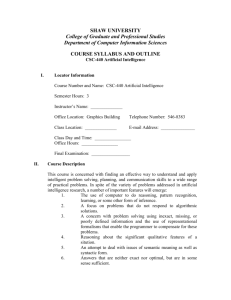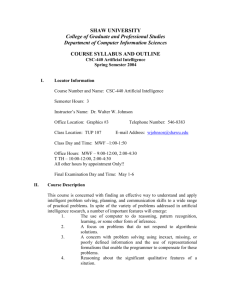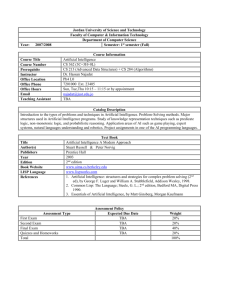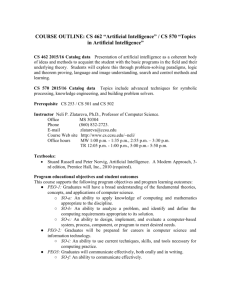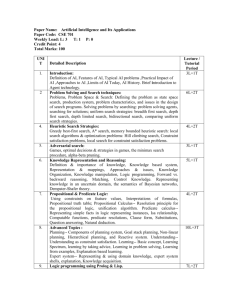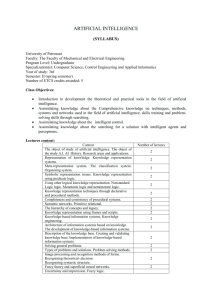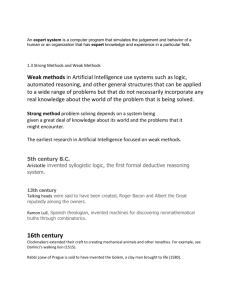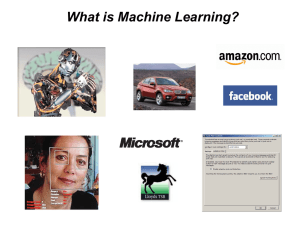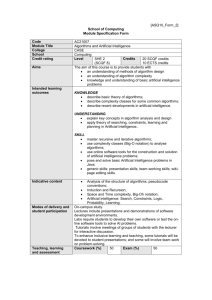Course Information - Jordan University of Science and Technology
advertisement
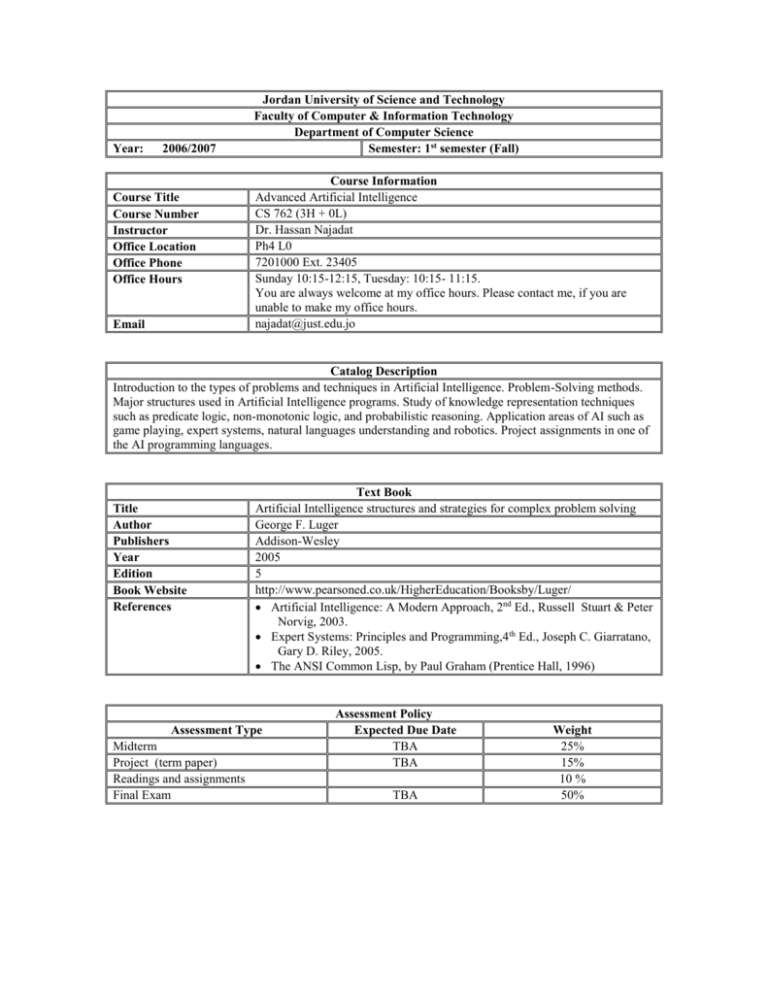
Year: 2006/2007 Course Title Course Number Instructor Office Location Office Phone Office Hours Email Jordan University of Science and Technology Faculty of Computer & Information Technology Department of Computer Science Semester: 1st semester (Fall) Course Information Advanced Artificial Intelligence CS 762 (3H + 0L) Dr. Hassan Najadat Ph4 L0 7201000 Ext. 23405 Sunday 10:15-12:15, Tuesday: 10:15- 11:15. You are always welcome at my office hours. Please contact me, if you are unable to make my office hours. najadat@just.edu.jo Catalog Description Introduction to the types of problems and techniques in Artificial Intelligence. Problem-Solving methods. Major structures used in Artificial Intelligence programs. Study of knowledge representation techniques such as predicate logic, non-monotonic logic, and probabilistic reasoning. Application areas of AI such as game playing, expert systems, natural languages understanding and robotics. Project assignments in one of the AI programming languages. Title Author Publishers Year Edition Book Website References Text Book Artificial Intelligence structures and strategies for complex problem solving George F. Luger Addison-Wesley 2005 5 http://www.pearsoned.co.uk/HigherEducation/Booksby/Luger/ Artificial Intelligence: A Modern Approach, 2nd Ed., Russell Stuart & Peter Norvig, 2003. Expert Systems: Principles and Programming,4 th Ed., Joseph C. Giarratano, Gary D. Riley, 2005. The ANSI Common Lisp, by Paul Graham (Prentice Hall, 1996) Assessment Type Midterm Project (term paper) Readings and assignments Final Exam Assessment Policy Expected Due Date TBA TBA TBA Weight 25% 15% 10 % 50% Course Objectives This course provides students major areas of AI including theorem proving, heuristic search, problem-solving, computer analysis of scenes, robotics, natural language understanding, and knowledge-based systems: Weights (20%) 1. The student will be able to solve problems using the AI techniques and the overall AI philosophy. 2. The student will be able to develop programs in LISP, PROLOG and other AI programming notations. 3. Introduce the foundations of Artificial Intelligence (including search, logical induction, constraint satisfaction problem, natural language, and different approaches to automated learning). (20%) 4. Understanding of knowledge-intensive system architectures, including rule-based, casebased, and model-based systems. (10%) 5. Understanding of issues underlying reasoning under uncertainty and knowledge of various approaches, including logics for non-monotonic reasoning, truth maintenance systems, and stochastic systems. (10%) 6. Understanding of the algorithms of various machine learning paradigms and their capabilities. (30 %) Teaching & Learning Methods lecture notes, homework assignments, and projects are designed to achieve the course objectives. You should read the assigned chapters before class, complete assignments on time, and participate in class among other things to understand the material. You should ask questions, whether in class or during office hours. You are responsible for all material covered in class. If you have any concerns, please communicate them to me either in class or by email. Related Objective 1 1 2 3 3 3 4 5 5 6 (10%) Learning Outcomes The expected achieved outcome Provide a brief history of major areas of AI Understand the predicate calculus to describe the essential features of problem Write intelligent programs using LISP and Prolog programming language. Ability to represent a problem solution as a path in a graph from a start to a goal. Know most search algorithms and data structures used to implement search. Define different problems in constraint satisfaction analysis and know the main approaches of forward and backward checking Identify different representations for AI such as conceptual dependency, semantic nets, frames, rule-based expert system along with case-based reasoning Draw useful conclusions from incomplete and imprecise data with unsound reasoning using truth maintenance and logic based abduction. Build models for reasoning with uncertainty using Bayesian models, belief networks, Dempster-Shafer, and the Stanford certainty algebra. Ability to discover useful information using various algorithms for Reference Ch 1 Ch2 Ch 15, ch 16 3.1 3.2-3.4, ch 4 [Ch 5 Russel l] Ch 6, 7, 8 9.1 9.2 Ch 10 symbol-base learning which includes induction, concept learning, and ID3 Know neural networks architectures including perceptron learning, and back propagation. Understand genetic algorithms and evolutionary approaches. Know different approaches of language understanding . 6 6 3 Week 1 2 3 4 5 6/7 7/8 8/ 9 9 10-11.5 11.5- 12 13 14-16 Readings Office Hours Homeworks Drop Date Midterm Project Policies Course Contents Topics AI: history and applications The predicate calculus An introduction to LISP Structures and strategies for state space search Heuristic search Building control algorithms for state space search. An introduction to PROLOG Constraint Satisfaction Problem Knowledge Representation [ Semantic Nets, Frames, Conceptual Graphs,…] Strong Method problem Solving [Rule-Based Expert System, Case-Based,…] Reasoning in uncertain Situations [Logic-Based Adductive Inference, Abduction, Stochastic Approach] Machine learning: symbol-Based Midterm Machine learning: Connectionist [Neural Network] Machine learning: The Genetic Algorithms Understanding Natural Language Project/Research paper presentations Ch 11 Ch 12 Ch 14 Readings Chapter 1 Chapter 2 Chapter 16 Chapter 3 Chapter 4 Chapter 6 Chapter 15 Chapter 5 Ref1 Chapter 7 Chapter 8 Chapter 9 Chapter 10 Chapter 11 Chapter 12 Chapter 14 Additional Notes Readings in addition to the book will be required. Occasionally notices will be posted to the class web page. You are responsible for checking this information weekly. Feel free to send me questions by electronic mail. It will be usually answered the same day. If you wish to see me in my office, please make an appointment by email. I am generally available, and I think that such flexible office hours will work better for you. Homeworks are due at the beginning of class Late homeworks will not be accepted All works have to be done independently Students handing in similar homeworks will receive a grade of 0 (ZERO) and face possible disciplinary actions The last day to drop the course is the 14-12-2006 You are expected to take the midterm. There will be no make-up unless you have a valid medical reason to have missed the midterm confirmed officially. Each student will pick a topic, a new RESEARCH idea of yours, NOT A PRESENTATION OF IDEAS FROM SOME PAPER. Students will research the topic, write a quality paper and give a quality presentation on it. Required materials Attendance Code of Conduct Presentations will be judged on contribution, interestingness, depth, correctness, clarity, and insight. Text, email, and WWW access are required. Students are expected to attend all classes If a student misses 10% of the classes without an acceptable reason, the student will be assigned a grade of 35, according to the rules of JUST. The assignments, and of course the quizzes, and exams need to be done individually. Copying of another student's work or code, even if changes are subsequently made, is inappropriate, and such work or code will not be accepted. The University has very clear guidelines for academic misconduct, and they will be enforced in this class.
